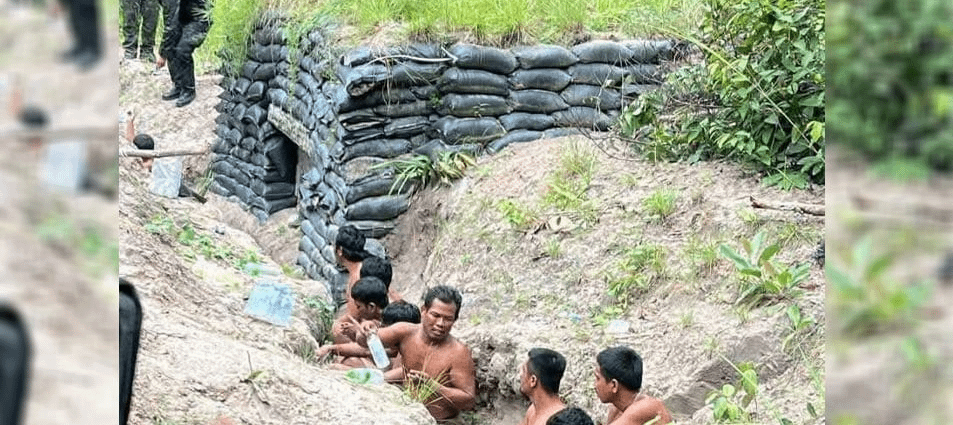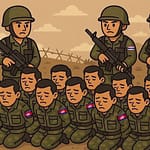On July 29, 2025, Thai troops captured twenty Cambodian soldiers near the Chong Te border crossing. This occurred just half a day after Malaysia helped bring an end to the fighting. The Cambodian military said Thai troops had invited the soldiers to take a commemorative photograph. As they drew closer, they were caught by hidden forces that emerged from the forest. One Cambodian soldier died as a result of the incident.
It has been 41 days since their capture. One of the two soldiers who have been returned is physically disabled; the other is showing signs of mental trauma. They are both very sick. The body of a dead soldier was sent back on July 31. At this time, it is not clear what the legal status or treatment of the eighteen Cambodian soldiers in Thai custody is.
A Ceasefire Undermined
The incident occurred immediately following a five-day conflict between the two nations that occurred from July 24 to 28. The fighting destroyed villages, damaged cultural sites and forced people to flee their homes. Late on July 28, Malaysia, the ASEAN chair, alongside the US and China, facilitated a ceasefire. This gave people hope that the conflict would soon be over. But the arrest of Cambodian troops brought back tensions and made people wonder how committed Thailand was to peace, less than 12 hours later.
Human Consequences
The return of two Cambodian soldiers has made the human cost of the stalemate clearer. Reports say that one of the two had serious physical injuries, including malnutrition and paralysis. The second person showed signs of post-traumatic stress disorder (PTSD), and Cambodian doctors said that his condition was caused by being alone for a long time and being mistreated. Thai officials have denied these claims, which have only strengthened calls for an impartial investigation.
The families of the missing soldiers are still not sure what to do. The public’s calls for answers from wives, parents and children have made it clear that trust between communities on both sides of the border is fading. Their testimony has made it even more crucial for Phnom Penh to seek assistance from other countries.
Legal and Diplomatic Dimensions
The Cambodian Human Rights Committee (CHRC) petitioned the Office of the UN High Commissioner for Human Rights (OHCHR) on August 1, requesting an investigation, accountability measures, medical care and a fact-finding mission.
Thailand claim that the soldiers crossed into Thai territory and should be tried in Thai courts. However, this stance appears to contradict the ceasefire timeline and could exacerbate mistrust between the two sides. Under international humanitarian law, the detention raises numerous important questions. The 1949 Geneva Conventions say that prisoners of war must be released and sent home right away after fighting stops. Both Cambodia and Thailand are signatories to these treaties.
A Pattern of Tension
This is the most recent in a long line of border problems between the two countries. After Cambodia successfully registered the Preah Vihear Temple as a UNESCO World Heritage site in 2008, fighting broke out. The violence got worse again in 2011, so the International Court of Justice (ICJ) and ASEAN had to step in. The ICJ reaffirmed Cambodia’s sovereignty over the temple in 2013, although there are still disagreements about the land around it.
These kinds of crises keep happening, which shows how weak bilateral mechanisms are and how they hurt ASEAN’s ability to act as a mediator in conflicts.
Regional Implications
Some analysts say that the arrest of Cambodian soldiers shows “low diplomacy”, which means making short-term tactical moves that hurt long-term stability. Using detained soldiers as leverage not only threatens to make the bilateral dispute last longer, but it also hurts ASEAN’s efforts to build trust in the region.
Cambodia has asked the UN to investigate the case, which suggests that it has less faith in direct dialogue. This event is a test for ASEAN to see if it can handle security issues that arise within its own members.
Conclusion
The events at the Chong Te crossing show what can happen when you break ceasefire agreements and ignore international rules. Thailand’s continued detention of Cambodian soldiers could make things worse for both sides and hurt ASEAN’s role as a stabilising force in Southeast Asia.
To stop things from getting worse, Thailand should speed up the return of the remaining detainees, let independent people check on how they are being treated, and talk openly with Cambodia. If these steps aren’t taken, this incident could turn into another chapter in a long history of border disputes that have not been resolved. This pattern makes it harder for regional organisations that are supposed to keep the peace and for bilateral relations to be taken seriously.
This article was originally published in The Phnom Penh Post. It is republished here with proper attribution. You can read the original version: https://www.phnompenhpost.com/opinion/handshake-turned-trap-betrayal-of-20-cambodian-soldiers-after-ceasefire







